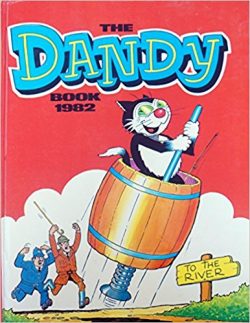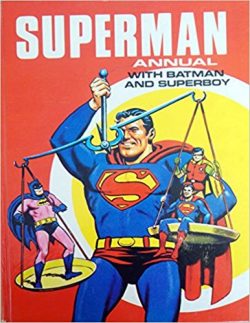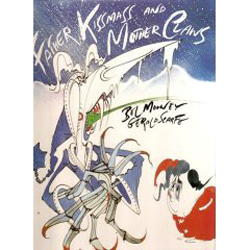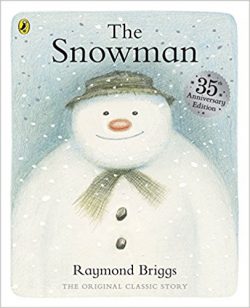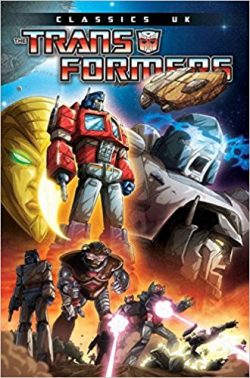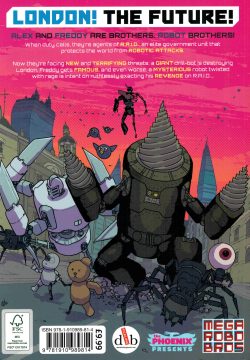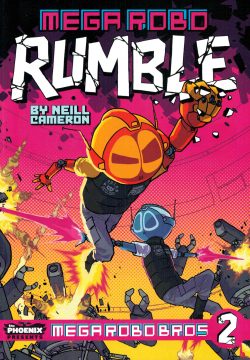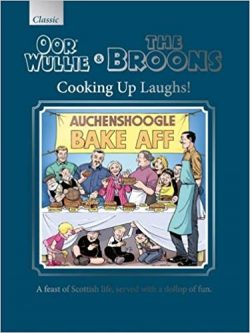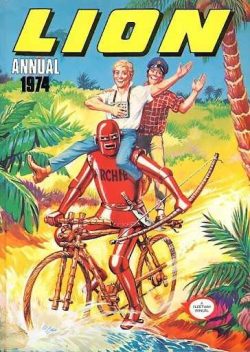
By many and various (Fleetway)
No ISBN – SBN 85037-067-1
Being almost universally anthology weeklies, British comics over the decades have generated a simply incomprehensible number of strips and characters in a variety of genres ranging from the astounding to the appalling. Perhaps it’s just personal bias based on being the right age at the right time, but the 1970s adventure material from Fleetway Publications seems to me the most imaginative and impressive of a long line of pictorial pleasures.
Fleetway was a small division of IPC – then the world’s largest publishing company – and had, by the early 1970s, swallowed or out-competed all other English outfits producing mass-market comics except the exclusively television-themed Polystyle Publications.
As it always had been, the megalith was locked in a death-struggle with Dundee’s DC Thomson for the hearts and minds of their assorted juvenile markets – a battle the publishers of the Beano and Dandy finally won when Fleetway sold off its dwindling comics line to Egmont Publishing and Rebellion Studios in 2002.
The 1950s had ushered in a revolution in British comics. With wartime restrictions on printing and paper lifted, a steady stream of new titles emerged from many companies and when the Hulton Press’ The Eagle launched in April 1950, the very idea of what weeklies could be altered forever.
The oversized, prestige package graced with lush photogravure colour was exorbitantly expensive, however, and when London-based publishing powerhouse Amalgamated Press retaliated with their own equivalent, it was (understandably) a more economical affair.
I’m assuming they only waited so long before the first issue of Lion debuted (dated February 23rd 1952), to see if their flashy rival periodical was going to last…
Like The Eagle, Lion was a mix of prose stories, features and comic strips and had its own cover-featured space-farer… Captain Condor – Space Ship Pilot.
Initially edited by Reg Eves, the title eventually ran for 1156 weekly issues until 18th May 1974 when it merged with Valiant. Along the way, in the traditional manner of British comics (which subsumed weaker-selling titles to keep popular strips going), Lion absorbed Sun in 1959 and Champion in 1966; even swallowing Eagle itself in April 1969 before merging with Thunder in 1971.
Despite its being one of the country’s most popular and enduring adventure comics, Lion vanished in 1976 when Valiant was amalgamated with Battle Picture Weekly.
Despite the weekly’s demise, there were 30 Lion Annuals between 1953 and 1982, all targeting the lucrative Christmas market, combining a broad variety of original strips with prose stories; sports, science and general interest features; short humour strips and – increasingly from the 1970s – reformatted reprints from IPC/Fleetway’s vast back catalogue.
This edition is technically the penultimate “proper†Lion Annual. In May 1974 the long-running title was merged with Valiant as very much the junior partner.
Valiant itself would be absorbed into Battle Picture Weekly two years later but although the title itself was on its uppers, the Christmas Annual market worked on different principles and retailers seemed ever-eager to see familiar names when stocking up on one-off big-ticket items.
The memory of many defunct comics survived for years beyond their demise because publishers kept on banging out hardback collections for titles parents and retailers remembered from their own pasts.
Lion Annual 1974 was released in Autumn 1973, the 21st volume since the comic began. There would be nine more before the hallowed name finally vanished from vendors’ shelves…
Boasting the traditional blend of full-colour, duo-tone and monochrome sections, this titanic tome kicks off in procedural manner and rainbow hues as ‘Spot the Clue with Zip Nolan’ (art by Ted Kearon) finds the motorcycle cop spectacularly solving theft at a logging camp after which a prose outing for ‘The Spellbinder’ (probably written by Tom Tully and spot-illustrated by regular strip artist Geoff Campion) reveals how young Tom Turville and his ancient alchemist ancestor Sylvester accidentally activate – and thwart – a terrorist fifth column menacing Britain…
‘Mowser the Priceless Puss and his Enemy James the Butler’ sees Reg Parlett’s cosseted kitty score another hilarious win in his ongoing war with malign manservant (and obnoxious, obstreperous, uppity snob) James after his cat-loving boss suggests a picnic, before ‘Secrets of the Demon Dwarf’ (Alfonso Font art) finds time-displaced WWI mad scientist Doktor Gratz still trying to reverse the result of the Great War by attacking modern-day Britain with robot stormtroopers, mole machines and his infamous armoured Zeppelin…
Campion’s ‘World Beaters: Peugeot Bébé’ delivers a fact-filled profile of the tiny foreign car after which Ian Kennedy depicts ‘Paddy Payne and the Battle of Eagles’ with the Air Ace seconded to the Maginot Line and embroiled in a grudge match between obsessed officers on both sides fighting to retain or retrieve a hotly contested battle standard…
‘Mowser’ then puts paid to James’ spotless reputation and – following two pages of general ‘Jokes’ – prose thriller ‘The Giant Dog of the Mause Valley’ explores the legend of a mythical hound before a bunch of irrepressible youngsters dubbed the ‘Can- Do-Kids’ thwart a conniving property tycoon in text treat ‘Moving House’…
Created by E. George “Ted†Cowan & Alan Philpott, The Jungle Robot debuted in the first issue of Lion in 1952, before vanishing until 1957. On his triumphant return in the 1960s as Robot Archie, “old tin bonce†became one of the most popular and long-lasting heroes of British comics.
Here the amazing and iconic automaton and his hapless handlers Ted Ritchie and Ken Dale find themselves fighting fake sharks and cunning gold thieves on the Amazon River in a sterling strip limned by Ted Kearon, after which photo-feature ‘Waterspeed’ outlines the intrinsic allure of powerboats.
Another ‘Jokes’ selection segues into sinister drama ‘The White-Eyes’ with wicked mad mastermind Ezra Creech using his super-strong zombie mind-slaves to steal army weapons and further his war against humanity. Happily, plucky teens Nick Dexter and Don Redding still have the measure of the malign maniac and his shambling myrmidons…
After ‘Mowser’ enjoys a spot of fishing, ‘The Spellbinder’ returns in strip form to lay a few unhappy ghosts at a Suffolk stately home after which another Campion ‘World Beater’ – ‘Meganeura Super Bug’ offers a glimpse at a prehistoric dragonfly before we all head back to WWII where schoolboy strategic prodigy ‘General Johnny’ (illustrated by Renato Polese perhaps?) sees the modern Alexander caught behind German lines and forced to fight his way back to safety…
Fire alarm foolishness makes ‘Mowser’ all warm inside and out after which ‘The Last of the Harkers’ finds hapless last surviving heir Joe and his ghostly coach attempting to reclaim a dead ancestor’s trophy and title for the Arduous Training and Obstacle Course in Glen Sporran. Joe was attempting to recover all the clan’s past prizes as a legal requirement to save the family seat, whilst villainous speculator Bert Swizzle saw the contests as his opportunity to take over the ancient pile…
This time, the rogue thought swapping dummy ordnance for the real thing would stop Joe, but he couldn’t be more wrong…
Brits of this period much preferred fantastic villains and antiheroes to straight do-gooders, and prose yarn ‘The Shadow of the Snake’ here heralds the return of an extremely popular serpentine super-crook.
Angus Allan & John Catchpole’s had begun the ophidian epic in the weekly Lion in 1972; cataloguing outrageous crimes of mad scientist Professor Krait who could transform himself into a reptilian rogue with all the assorted evolutionary advantages of the world’s reptilian denizens.
Here the bizarre bandit’s plan to plunder a bullion train is countered by his mortal nemesis and former lab assistant Mike Bowen, who regularly advises the bewildered, overmatched police…
A text examination of Alexander Selkirk – ‘The Real Robinson Crusoe’ – leads into a moth-eaten episode for ‘Mowser’ after which ‘Spot the Clue with Zip Nolan’ monochromatically features the canny cop scotching a criminal scheme operating as a civil war re-enactment whilst prose account ‘Anchored to a Blazing Hurricane!’ retells a shocking event from the Battle of Britain.
Following a prose outing details Robot Archie liberating a Burmese ruby mine from river pirates, photo-feature ‘Do It Yourself War’ celebrates table-top military gaming, ‘Mowser’ meets a snooty pedigree mutt and a full-colour match starring underage professional footballers ‘Carson’s Cubs’ (art by Fred T. Holmes) details how a subversive dietician can wreak more havoc than a bent referee on a successful team…
Stuntmen brothers Joe and Sandy then earn their title as ‘The Speed Kings’ after stumbling into a plot to sabotage a powerboat record attempt whilst text thriller ‘Noah’s Ark’ reveals how survivors cope with a flooded world before this walk down memory lane wraps up with the surely prophetic ‘“Stop this Man†Say the Camelot Clan’ wherein wealthy American speculators plan to turn the entire United Kingdom into a giant gasworks.
Only a disparate and slightly bonkers Historical Preservation Society stand in their way, but these fulminating little Englanders have a few tricks up their sleeves and the latest foray – to pave over Loch Ness and build a power station – flops for the strangest and most obvious reasons…
This is a glorious lost treasure-trove for fans of British comics and lovers of all-ages fantasy, filled with danger, drama, hobby-data and diverse delights, illustrated by some of the most talented artists in the history of the medium. Track it down, buy it for the kids and then read it too. Most of all, pray that somebody somewhere is actively working to preserve and collect these sparkling and resplendent slices of our fabulous graphic tradition in more robust and worthy editions.
© IPC Magazines Ltd. 1974. All rights reserved.

